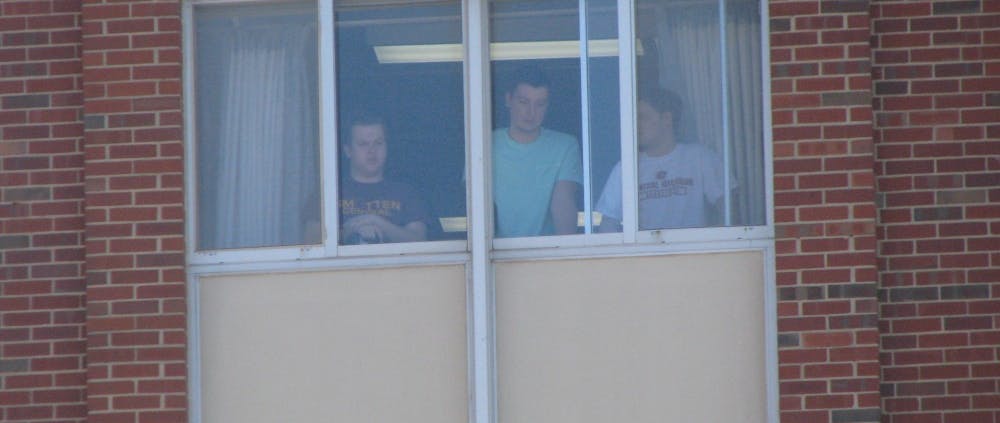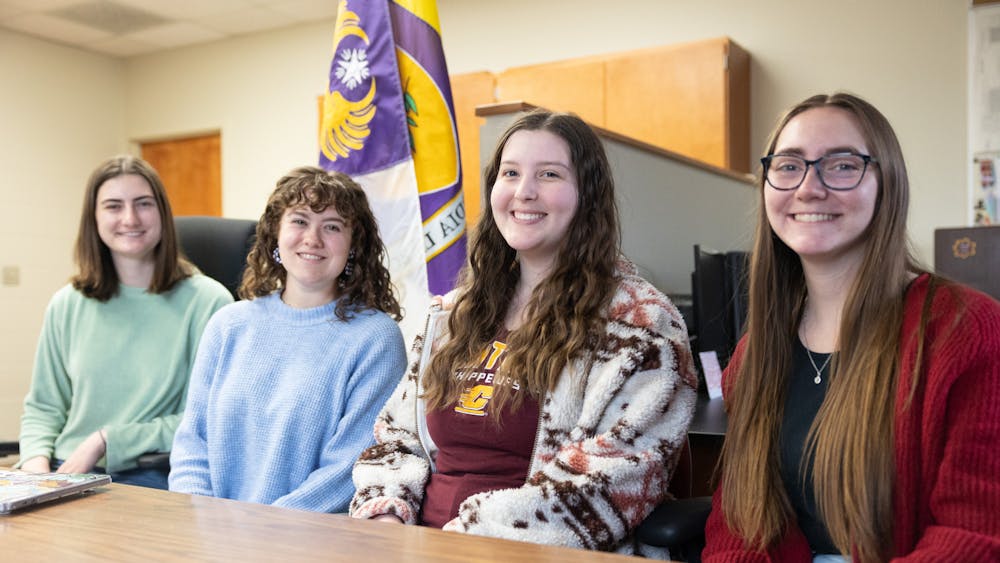University seeking feedback, analyzing procedures following March 2 shooting

Students watch from their windows as police arrive on the scene on March 2 at Towers Residence Halls.
University officials largely believe emergency procedures worked after a double homicide took place on campus March 2.
Jonathan Webb, associate vice president of Facilities Management, said keeping campus safe on March 2 was made easier by the cooperation of students, faculty and staff.
“I think it’s a lot about the attitude of people here at Central (Michigan University) — a lot of Midwest values of people taking care of each other,” Webb said.
Both Webb and Lt. Cameron Wassman of the CMU Police Department mentioned the phrase “shelter in place” played a key role in communications with students, faculty and staff. The phrase refers to seeking shelter within the building one is already occupying rather than evacuating or seeking a designated emergency shelter.
While there are policies and procedures in place for emergency situations on campus, Wassman said there is no protocol in place for a “lockdown” situation.
The size and scope of campus, as well as the fact that every emergency management scenario is unique, can make it challenging to create an effective campus-wide policy, Webb said.
“The goal is ensuring people are safe — that means keeping people who are inside a facility in and making sure people outside those facilities can find a place to go and be safe,” Webb said.
Ensuring safety can be different depending on what areas of campus students, faculty and staff are located.
Margaret Desormes, assistant director for the Child Development and Learning Laboratory, said the laboratory staff have many procedures already in place because of the shooting that took place at Sandy Hook Elementary School in 2012.
The lab consults with both CMUPD and the Mount Pleasant Police Department to ensure they are following the best practices laid out by the departments, Desormes said.
The lab is not open to children on Fridays, so there were none present on March 2. Regardless, she said staff locked down the lab in less than three minutes.
The lab will continue to make changes as needed to its procedures but many of the policies in place worked well on March 2, Desormes said.
For many students, March 2 involved seeking shelter in residence and academic halls for up to six hours before being escorted out by police.
“It was very inconvenient for people being sheltered for an extended period of time, but everyone else got to go home to their loved ones or call mom and dad,” Webb said. “Is there room for improvement? Sure, there always is.”
Webb said the university is trying to gather as much data as it can to see what went right and wrong.
“For a lot of people on campus, it’s been every day,” he said. “Some sort of meeting or analysis that’s taking place that is leading to changes and improvements.”
Wassman said a large reason that campus was told to “shelter in place” for such a long period of time was simply because the suspect’s location was unknown during that time.
The CMUPD has reached out to the FBI as well as the U.S. Department of Homeland Security for advice following the incident, Wassman said. One of the goals moving forward is trying to ensure the university’s communication with students during emergency events is clear and precise.
“These expectations and definitions and processes will not be a surprise to people,” Wassman said. “We will be training (students, faculty, and staff) and have been.”
Wassman said that currently all incoming freshman and employees of the university take part in fire safety training, and that training could be expanded to include other safety issues.
The CMUPD also does training with groups on campus upon request and can cover fire, tornado, and hazardous material safety procedures. CMUPD also does “stay safe” training, which covers what to do in an active shooter scenario: get out of the area, hide out, or take out the threat.
The CMUPD also offers many of its training materials online, Wassman said.
The university is encouraging a discussion about the event and hopes those who would like to say something speak up, Webb said.
Students can voice their feedback through the Student Government Association or their residence hall directors. Webb said faculty and staff are being encouraged to talk with their supervisors.
“That dialogue is good because it helps people heal and share their feelings,” Webb said. “It’s also very good for other people to realize others have those feelings, too.”







